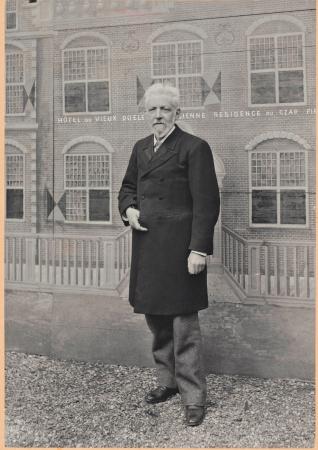On December 22, the Peace Palace Library, the International Network of Museums for Peace (INMP) and the Bertha von Suttner Peace Institute organized a commemorative meeting to mark the 100th anniversary of the death of Felix Stone Moscheles. Moscheles was a 19th century peace activist and painter. He was one of the best-known pacifists of his time, a familiar face in the International Peace Movement and a close friend of Bertha von Suttner, the first female recipient of the Nobel Peace Prize. He participated in the Hague Peace Conferences and was a staunch supporter of international arbitration. This blog will briefly discuss his life and will mainly focus on his peace activities.
Felix Stone Moscheles was born in London into a German Jewish family. He was the son of a famous composer, conductor and piano virtuoso, Ignaz Moscheles. His mother Charlotte was originally from a German Jewish family from Hamburg. Ignaz Moscheles and his wife settled in London during the first quarter of the 19th century where he became a co-director of the Royal Philharmonic Society. He named his son Felix after one of his best pupils, Felix Mendelsohn, who also became a famous composer and conductor with whom Ignaz Moscheles professionally collaborated.
Like his father, Felix Moscheles was artistically inclined. However, his heart and talent was mostly focused on painting. He studied in Antwerp and became known as a portrait painter. His work was later exhibited in Paris and London. He painted portraits of prominent people in the peace movement such as British pacifist Hodgson Pratt and Swiss pacifist Élie Ducommun, American President Grover Cleveland, James Roosevelt (FDR’s father), the poet and playwright Robert Browning and Russian composer Anton Rubinstein. In 1913, around the official opening of the Peace Palace, he donated his painting of Élie Ducommun to the Permanent Court of Arbitration. Since then, this painting is part of the Peace Palace Art Collection. During the Commemorative meeting, Peace Palace art historian, Ms. Jacobine Wieringa, gave a brief presentation on the painting of Élie Ducommun and the correspondence between Moscheles and the chairman of the Carnegie Foundation.
It appears that his activities to advance the cause of peace first started in 1878, when he became a member of the International Arbitration and Peace Association in London which was then headed by Hodgson Pratt. In 1897, Moscheles himself became chairman of this organization. His peace activities led him to partake in the First Hague Peace Conference in 1899.
In ‘A History of the Peace Conference at The Hague’, Felix Moscheles wrote of his impressions:
‘For the first time in the annals of the past the solidarity of mankind is recognised, and Internationalism takes its place as a factor in the history of the future. […] What was an old dream has become a new science'.
Upon arriving in The Hague, Moscheles was dubbed the ‘nestor’ of the international peace movement by the Dutch newspapers. During his stay, Moscheles operated alongside Bertha von Suttner and famous peace activists such as William Stead and Jean de Bloch. As they were not part of the official delegations, they considered themselves outsiders of the Conference. Together they organized and attended informal meetings and communicated with journalists to advocate the establishment of a ‘World Court’.
In 1906, Moscheles became the first president of the London Esperanto Club. Like many Esperantists, he strongly believed that an international language would help prevent conflicts between nations and would further international understanding between peoples.
In 1913, he attended the British Peace Congress in Leeds where he submitted a resolution to recognize Esperanto as a means to bring people together and to use this new language as a functional tool for communication in all peace conferences and congresses. The resolution was accepted.
Moscheles also published a peace journal titled ‘The Concord’ and later became a member of the International Peace Bureau in Bern. His work and efforts to advance the cause of peace, resulted in a total of 19 nominations for the Nobel Peace Prize. Unfortunately, he never won. He died on December 22, 1918 at the age of 84.
We ended the commemorative meeting with some music by composer Felix Mendelsohn and a small lovely get-together with tea and biscuits organized by Ms. Petra Keppler of the International Network of Museums for Peace and the Bertha von Suttner Peace Institute.
For more information, please send a message to library@peacepalace.org.
N.B. The Image of Felix Moscheles was taken during the First Hague Peace Conference in 1899 in The Hague, The Netherlands and is part of the image collection of the Dutch Carnegie Foundation.
